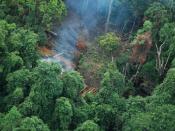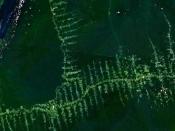Deforestation
Table of Contents
Introduction 1
Important Facts 1
Historical Background 1-2
Background Law 2
Causes of Deforestation 2
The Green House Effect 2-3
Reducing Deforestation 3
Case Studies 3-4
Pros and Cons 4-5
Conclusion 5
Bibliography 6
Ninety percent of our trees, 300 - 900 years old, have been cut down. The remaining 10% is all we will ever have. Deforestation is a significant issue of our time and must be taken seriously if we want to protect our remaining forests. The definition of deforestation by the Random House Dictionary of the English Language is 'to divest or clear of forests or trees' and we must stop deforestation to save our planet. My intent on writing this essay is to enlighten the reader about the facts on deforestation and to express my opinions about deforestation.
There are approximately 3 400 million hectares of forests in the world, nearly 25% of the world's land area.
Close to 58% of the forests are found in the temperate/boreal regions and 42% in the tropics. For about a millennium, people have benefited from the forests. Forest products range from simple fuelwood and building poles to sophisticated natural medicines, and from high-tech wood based manufactures to paper products. Environmental benefits include water flow control, soil conservation, and atmospheric influences. Brazil's Amozonia contains half of the world's tropical rain forests. The forests cover a region 10 times the size of Texas. Only about 10% of Brazil's rain forests have been cut to date, but cutting goes on at an uncontrollable rate.
Since pre-agricultural times the world's forests have declined one fifth from 4 to 3 billion hectares. Temperate forests have lost 35% of their area, subtropical woody savannas and deciduous forests have lost 25% and ever-green forests which are now under the most pressure have...


